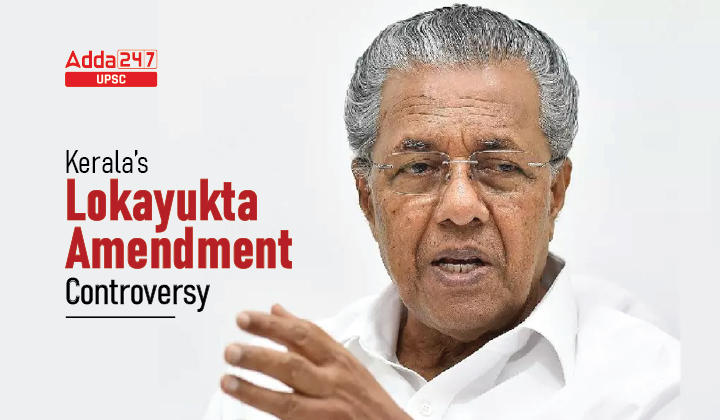Table of Contents
Kerala’s Lokayukta Amendment Controversy- Relevance for UPSC Exam
General Studies II- Polity and Governance.
In News
The Kerala Legislative Assembly passed the Kerala Lokayukta (Amendment) Bill amid a boycott.
Who are Lokpal-Lokayuktas?
- The Lokpal-Lokayukta term was first used in a report of the Administrative Reforms Commission headed by Morarji Desai in 1966.
- A system of an ombudsman should be established to redress public grievances against the leaders and public officials was the need as corruption had become rampant.
- The first Bill on Lokpal was introduced in the Lok Sabha in 1968 which lapsed with the dissolution of the House.
- Anna Hazare’s movement and the active involvement of civil society generated a lot of moral pressure on the Government which ultimately led to the passing of the Bill in 2013.
Composition of Lokpal
- The Lokpal is no ordinary investigative body.
- It is headed by the incumbent Chief Justice of India or a retired judge.
- It has eight members, four of whom are judicial members.
- Thus the whole system is studded with judges or judicial men.
- The Lokpal has an inquiry wing and a prosecution wing to deal with investigation and prosecution, respectively.
- The director of prosecution files the case in the special court based on the findings of the Lokpal.
Who falls under the ambit of Lokpal?
- The Lokpal has jurisdiction to inquire into allegations of corruption against the Prime Minister, Ministers, Members of Parliament, Group A, B, C and D officers and officials of the central government.
- After the conclusion of the investigation, the Lokpal may file a case in the special court in case the findings disclose the commission of offence under the Prevention of Corruption Act by the PM, Ministers or MPs.
- However, the Lokpal does not have the power to ask the President to remove the Prime Minister or a Minister from office.
What about the states?
- The Lokpal and Lokayukta Act delegates the power to States to establish by law the Lokayukta to deal with complaints relating to corruption against public functionaries.
- Some States already have established Lokayuktas. For example, Maharashtra in 1971, and Kerala in 1999.
What is the Keralan controversy?
- In order to get a clearer perspective on the Kerala Lokayukta controversy, it is necessary to understand the scheme of the Lokpal and Lokayuktas Act enacted by Parliament.
- The long title of the Act says: “An Act to provide for the establishment of a body of Lokpal for the Union and Lokayukta for States to inquire into allegations of corruption against certain public functionaries….”
- Thus, the Lokpal is conceived of as a body which will inquire into allegations of corruption.
- It is basically an investigative body whose task is to conduct prompt and fair investigation and the prosecution of cases of corruption.
Issues with the Amendment
- The amendments were related to the competent authority to consider Lok Ayukta recommendations.
- In the case of any unfavourable decision from the Lok Ayukta against the CM, the competent authority will now be the Legislative Assembly instead of the Governor as is prescribed in the existing Act.
- The amendment tries to take away at the powers of the Governor.
- The Lokayukta has indirectly expressed its resentment over the attempt to take away some of its powers.
Arguments by Kerala Government
- The Government, on the other hand, claims that through the amendment, a provision in the original Act which is unconstitutional has been excised.
- Earlier it gave power to the Lokayukta to give directions to the Governor to remove a CM or a Minister on being found guilty of corruption.
- This meant that the Lokayukta was to be over and above the office of Governor.
Legal and constitutional implications
- One, an investigative body does not have the legal authority to direct the public servant to resign his post on the basis of its findings.
- It can only submit its findings to the competent authority or, as is provided in the Lokpal Act, file a case in the special court.
- The Lokayukta is basically an investigative body with certain powers to carry out an investigation into cases relating to the Prevention of Corruption Act.
- The only special feature of this body is that it is headed by a retired judge of the Supreme Court or a retired Chief Justice of a High Court.
- But that does not alter the basic character of the Lokayukta as an investigative body.
- The Chief Minister or a Minister holds office during the pleasure of the Governor (Article 164).
- The Constitution of India does not contemplate any external pressure on the Governor to withdraw his pleasure.
- The Sarkaria Commission had suggested that the Governor can dismiss a Chief Minister only when he loses his majority in the Assembly and refuses to step down.
- The Supreme Court has accepted this recommendation of the Sarkaria Commission.
- Another occasion when the Governor could withdraw his pleasure is on account of CM having been convicted in a criminal case and sentenced to not less than two years of imprisonment.
- In other words, a Chief Minister cannot be asked to resign when he enjoys a majority in the House.
- The Governor, being a high constitutional authority, cannot be compelled by a law to act in a particular manner so far as his constitutional duties and functions are concerned.
Other contentious provisions
- There are some other provisions as well which may not stand legal scrutiny.
- For example, this law includes the office bearers of political parties within its definition of ‘public servant’.
- Basically, the Prevention of Corruption Act deals with corruption in the government and allied agencies, statutory bodies, elected bodies, etc.
- The functionaries of political parties do not come within the mischief of this law. So, it is difficult to understand how they can be brought within the sweep of the Lokayukta Act.
- Another problematic provision in this law is the one which deals with the reports of Lokayukta (Section 12).
- It says that the Lokayukta shall, on the allegation of corruption being substantiated, send the findings along with recommendation of action to the competent authority who is required to take action as recommended by the Lokayukta.
- It further says that if the Lokayukta is satisfied by the action taken by the competent authority, he shall close the case.
- The question is how the Lokayukta can close a corruption case which is a criminal case and which invites imprisonment for three to seven years.
- The Lokpal files the case in the court after the investigation. There is no provision in the central law under which the Lokpal can close the case before it reaches the court.
- The Lokayukta not being a court does not have the legal capacity to close the corruption case under any circumstances.
Way forward
- The Kerala Lokayukta Act should be re-examined by a committee of the Assembly and should be brought on a par with the Lokpal Act.
- Legislation that seeks to punish corrupt functionaries should be placed above controversies.




 TSPSC Group 1 Question Paper 2024, Downl...
TSPSC Group 1 Question Paper 2024, Downl...
 TSPSC Group 1 Answer key 2024 Out, Downl...
TSPSC Group 1 Answer key 2024 Out, Downl...
 UPSC Prelims 2024 Question Paper, Downlo...
UPSC Prelims 2024 Question Paper, Downlo...
